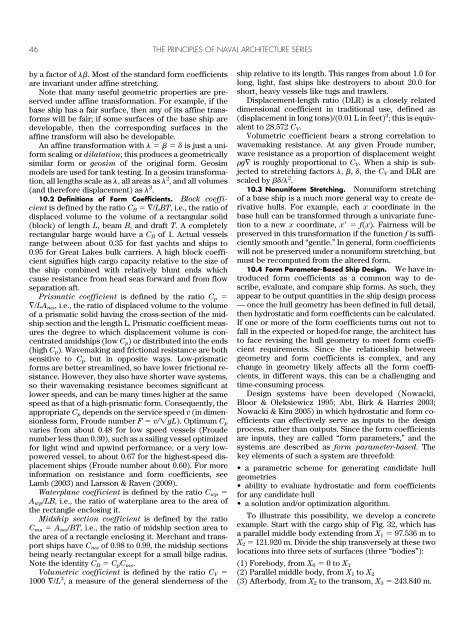The Geometry of Ships
Create successful ePaper yourself
Turn your PDF publications into a flip-book with our unique Google optimized e-Paper software.
THE GEOMETRY OF SHIPS 45<br />
where:<br />
L and M are the restoring moments about the longitudinal<br />
and transverse axes respectively;<br />
and are heel and trim angles;<br />
I xx and I yy are the moments <strong>of</strong> inertia <strong>of</strong> the waterplane<br />
area about longitudinal and transverse axes through<br />
CF;<br />
is the displacement volume;<br />
z B and z G are the vertical heights <strong>of</strong> the center <strong>of</strong> buoyancy<br />
and center <strong>of</strong> gravity respectively.<br />
Because these coefficients pertain to small displacements<br />
from an equilibrium floating attitude, they are<br />
called transverse and longitudinal initial stabilities.<br />
<strong>The</strong>ir dimensions are moment/radian (i.e., force <br />
length / radian). <strong>The</strong>y are usually expressed in units <strong>of</strong><br />
moment per degree.<br />
Initial stability is increased by increased moment <strong>of</strong><br />
inertia <strong>of</strong> the waterplane, increased displacement, a<br />
higher center <strong>of</strong> buoyancy, and a lower center <strong>of</strong> gravity.<br />
Because <strong>of</strong> the elongated form <strong>of</strong> a typical ship, the longitudinal<br />
initial stability is ordinarily many times greater<br />
than the transverse initial stability.<br />
It is common to break these formulas in two, stating<br />
initial stabilities in terms <strong>of</strong> the heights <strong>of</strong> fictitious<br />
points called transverse and longitudinal metacenters M t<br />
and M l above the center <strong>of</strong> gravity G:<br />
dL/d g(z Mt z G ) (z Mt z G ) (108)<br />
dM/d g(z Ml z G ) (z Ml z G ) (109)<br />
where<br />
z Mt z B I xx / (110)<br />
z Ml z B I yy / (111)<br />
z Mt z G and z Ml z G are called transverse and longitudinal<br />
metacentric heights. <strong>The</strong>re is an alternative<br />
conventional notation for these stability-related vertical<br />
distances:<br />
B represents the center <strong>of</strong> buoyancy;<br />
M T the transverse metacenter;<br />
M L the longitudinal metacenter;<br />
G the center <strong>of</strong> mass; and<br />
K the “keel” or baseline.<br />
<strong>The</strong>n,<br />
BM T z Mt z B transverse metacentric radius<br />
BM L z Ml z B longitudinal metacentric radius<br />
KM T z Mt z K height <strong>of</strong> transverse metacenter<br />
KM L z Ml z k height <strong>of</strong> longitudinal metacenter<br />
KB z B z k center <strong>of</strong> buoyancy above baseline<br />
KG z G z k center <strong>of</strong> gravity above baseline<br />
GM T z Mt z G transverse metacentric height<br />
GM L z Ml z G longitudinal metacentric height.<br />
In terms <strong>of</strong> metacentric heights, in this notation, the<br />
initial stabilities become simply:<br />
dL/d GM T (112)<br />
dM/d GM L (113)<br />
Note that the metacenters are widely different for<br />
transverse and longitudinal inclinations. Metacentric<br />
heights are typically 10 to 100 times larger for longitudinal<br />
inclination, owing to the elongated form <strong>of</strong> most<br />
vessels.<br />
It is conventional in naval architecture to compare vessels<br />
<strong>of</strong> different sizes and proportions in terms <strong>of</strong> a number<br />
<strong>of</strong> ratios or dimensionless coefficients characterizing<br />
the form or shape. <strong>The</strong>se so-called form coefficients correlate<br />
to a useful degree with resistance, seakeeping and<br />
capacity characteristics, and provide considerable guidance<br />
in selecting appropriate proportions and displacement<br />
for a new ship design.<br />
<strong>The</strong> leading dimensions involved in the standard form<br />
coefficients are: displaced volume , waterplane area<br />
A wp , midship section area A ms , length L, waterline beam<br />
B, and draft T. Any <strong>of</strong> these quantities might be very<br />
clearly defined or might be ambiguous to varying degrees,<br />
depending on the type <strong>of</strong> vessel and its specific<br />
shape; these issues were discussed in Section 1.2.1 in relation<br />
to “particulars.” For example, appendages might<br />
or might not be included in displacement and/or length.<br />
A ms may refer to the midship section (at the midpoint <strong>of</strong><br />
L) or to the maximum section, which can be somewhat<br />
Section 10<br />
Form Coefficients for Vessels<br />
different. Of course, any uncertainty in the leading dimensions<br />
will produce corresponding variations in their<br />
ratios. To be definite about form coefficients, it is necessary<br />
to explicitly state the loading condition and, <strong>of</strong>ten,<br />
to specify which volumes are included and excluded. It<br />
is common to refer to “bare-hull” or “canoe-body” form<br />
coefficients when appendages are excluded.<br />
10.1 Affine Stretching. A given ship form can be<br />
transformed into a triply infinite family <strong>of</strong> other ships by<br />
a combination <strong>of</strong> linear (uniform) stretchings along the<br />
three principal axes. Uniform stretching by different<br />
amounts along different axes is called affine transformation<br />
in geometry. Suppose we start with a base ship form<br />
<strong>of</strong> length L, beam B, and depth D and apply multiplicative<br />
factors <strong>of</strong> , , along the longitudinal, transverse,<br />
and vertical axes respectively; then we arrive at a new<br />
ship with leading dimensions L, B, D. <strong>The</strong> displacement<br />
will be multiplied by a factor <strong>of</strong> , the midship<br />
section area by a factor <strong>of</strong> , and the waterplane area



